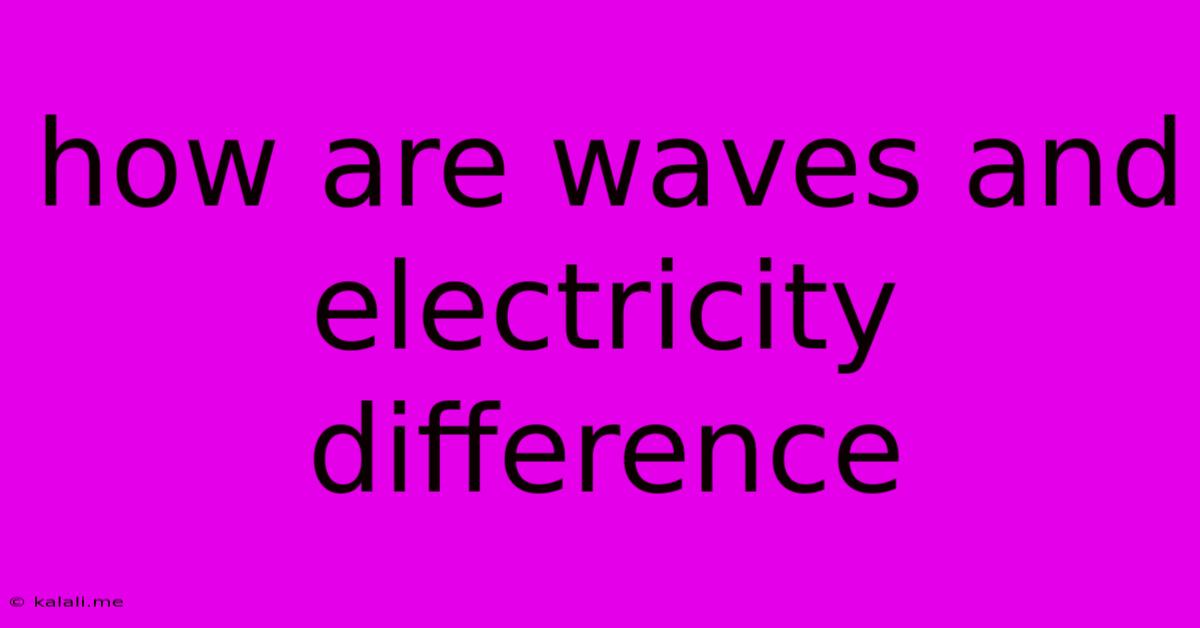How Are Waves And Electricity Difference
Kalali
May 25, 2025 · 3 min read

Table of Contents
How are Waves and Electricity Different? Understanding Fundamental Differences
Waves and electricity, while both capable of transferring energy, are fundamentally different phenomena. This article will explore the key distinctions between these two concepts, clarifying their nature and properties. Understanding these differences is crucial for comprehending various scientific and technological applications.
What are Waves?
Waves are disturbances that travel through a medium, transferring energy without transferring matter. Think of a ripple in a pond: the water itself doesn't travel across the pond, but the disturbance – the wave – does. This energy transfer can take many forms, leading to different types of waves:
- Mechanical Waves: These require a physical medium to propagate, such as sound waves traveling through air or water waves through water. They rely on the interaction between particles within the medium. Examples include seismic waves and ocean waves.
- Electromagnetic Waves: These don't need a medium to travel and can move through a vacuum. They are created by the interplay of oscillating electric and magnetic fields. Light, radio waves, X-rays, and microwaves are all examples of electromagnetic waves.
What is Electricity?
Electricity, in its simplest form, is the flow of electric charge. This charge is typically carried by electrons, subatomic particles with a negative charge. The movement of these electrons creates an electric current, which can be harnessed to do work. Key aspects of electricity include:
- Electric Charge: The fundamental property of matter responsible for electromagnetic interactions. Objects can have a positive, negative, or neutral charge.
- Electric Current: The rate of flow of electric charge, usually measured in amperes (amps).
- Voltage: The electric potential difference between two points, representing the driving force for the current.
- Resistance: The opposition to the flow of current, measured in ohms.
Key Differences between Waves and Electricity:
| Feature | Waves | Electricity |
|---|---|---|
| Nature | Disturbance propagating through a medium (or vacuum for electromagnetic waves) | Flow of electric charge |
| Medium | Requires a medium (mechanical waves) or doesn't require a medium (electromagnetic waves) | Doesn't necessarily require a medium for flow, but a conductor is often needed for practical applications |
| Energy Transfer | Transfers energy without transferring matter | Transfers energy through the movement of charge |
| Measurable Properties | Wavelength, frequency, amplitude, speed | Voltage, current, resistance, power |
| Types | Mechanical (sound, water, seismic) and Electromagnetic (light, radio, X-rays) | Direct current (DC) and Alternating current (AC) |
Interplay between Waves and Electricity:
While distinct, waves and electricity are interconnected. Electromagnetic waves are inherently linked to electric and magnetic fields. The generation and transmission of electricity often involves the use of electromagnetic waves, as seen in radio transmission and wireless communication. Conversely, electric currents can generate waves, like those used in sonar and radar technologies.
In Conclusion:
Waves and electricity, despite sometimes interacting, are fundamentally different physical phenomena. Waves represent disturbances that transfer energy, while electricity is the flow of electric charge. Understanding these differences and their interactions is critical for comprehending a vast array of scientific and technological principles. Further exploration into specific types of waves and their applications will provide a deeper understanding of the fascinating world of physics.
Latest Posts
Latest Posts
-
How To Loosen A Wheel Nut
May 25, 2025
-
Stepper Motor Driver Soem Does Not Work Control Frequency
May 25, 2025
-
Check The External Field Of The Error Object
May 25, 2025
-
Can You Use Linseed Oil Over Painted Wood
May 25, 2025
-
Wiring A Light Switch From An Outlet
May 25, 2025
Related Post
Thank you for visiting our website which covers about How Are Waves And Electricity Difference . We hope the information provided has been useful to you. Feel free to contact us if you have any questions or need further assistance. See you next time and don't miss to bookmark.